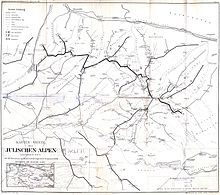Julius Kugy
Julius Kugy (born July 19, 1858 in Gorizia , Austrian Empire , † February 5, 1944 in Trieste ) was a mountaineer and writer . He is considered to be the developer of the Julian Alps .
Life
Julius Kugy studied law in Vienna and obtained his doctorate in 1882. From 1883 he managed the family business Pfeifer & Kugy in Trieste until it collapsed after the First World War.
As a child of his time, he turned to a variety of interests at an early age, including botany and organ playing . He got his access to mountaineering through his stays in his father's home village, near Arnoldstein . Even though he got to know large areas of the Alps , he dedicated his mountaineering career primarily to the Julians . Thanks to his solid financial resources at the time, he was able to surround himself with excellent mountain guides , often including local hunters, smugglers and shepherds, and thus managed numerous first ascents . Particularly noteworthy are Andreas and Joze Komac from the Trenta Valley (Slovenian), Osvaldo Pesamosca from the Raccolana Valley (Friulian-Italian) and Anton Oitzinger (German-Carinthian). Walking without a guide was generally seen as more valuable from a sporting point of view, but for Julius Kugy the sporty aspect of mountaineering was of secondary importance, for him the experience of nature was in the foreground.
During the First World War , at the age of 57, he volunteered as an "alpine consultant" for the Austro-Hungarian military staff on the Isonzo front . After the war, the now sixty-year-old stopped climbing after a hernia and devoted himself to writing. He died in poor conditions in Trieste during the Second World War .
Kugy is a household name for those who know the Julian Alps. Due to his sociable nature and old Austrian tolerance, he is equally respected by Austrians, Slovenes, Friulians and Italians, which is evident from numerous street names and monuments in the Trenta ( Slovenia ) and the Seisera, near Valbruna (Wolfsbach) in Italy , or in Carinthia, for example in Occupy Villach or Arnoldstein (Austria). There is hardly a valley in the Juliern in which a “Kugyweg” does not lead to some summit.
Although Kugy - as he writes in his book From the Life of a Mountaineer - was not able to speak the Slovene language, he is said to have lived in three languages, which is why he has recently become the leading figure for the Alpe-Adria concept , the three-country Olympic application “Senza-Confini”, school models such as the Kugy class at the Federal High School and Federal Real High School for Slovenes in Klagenfurt and most recently for the “Julius Kugy Prize” of the Carinthian Slovenes ' community .
Kugy was a member of the AGV (Academic Choral Society) Vienna.
In 1964 the Kugygasse in Vienna- Hietzing was named after him. In 2008 a Slovenian 45 euro cent stamp was dedicated to him.
Works
- From the life of a mountaineer. Bergverlag Rother , Munich 1925.
- Work - music - mountains. One life. Bergverlag Rother, Munich 1931.
- The Julian Alps in the picture. Leykam, Graz 1934 [issued 1933].
- Anton Oitzinger. A mountain guide life. Leykam, Graz 1935.
- Five centuries of Triglav. Leykam, Graz 1938 [issued 1937].
- In the divine smile of Monte Rosa. 2 volumes. Leykam, Graz 1940.
- From the past. Leykam, Graz 1943.
literature
- Hösch – Kaltenegger: Kugy, Julius. In: Austrian Biographical Lexicon 1815–1950 (ÖBL). Volume 4, Publishing House of the Austrian Academy of Sciences, Vienna 1969, p. 331 f. (Direct links on p. 331 , p. 332 ).
- Helga Kostka: Julius Kugy - alpinist and bestselling author (1858–1944) . In: ÖAV (Ed.): Bergauf . tape 4 , no. 63 (133) . Innsbruck September 2008, p. 44–46 ( alpenverein.at [PDF]).
- Karl Maidwoman: Kugy, Julius. In: New German Biography (NDB). Volume 13, Duncker & Humblot, Berlin 1982, ISBN 3-428-00194-X , p. 248 ( digitized version ).
Web links
- Hubert Bergmann: Modest King in the Kingdom of Triglav: Julius Kugy (1858-1944) - biography of the month on the homepage of the Austrian Biographical Lexicon (June 2020) .
- Literature by and about Julius Kugy in the catalog of the German National Library
- Personal folder on Julius Kugy (I) (PDF) in the historical Alpine archive of the Alpine clubs in Germany, Austria and South Tyrol (temporarily offline)
- Personal folder on Julius Kugy (II) (PDF) in the historical Alpine archive of the Alpine clubs in Germany, Austria and South Tyrol (temporarily offline)
- Personal folder on Julius Kugy (III) (PDF) in the historical Alpine archive of the Alpine clubs in Germany, Austria and South Tyrol (temporarily offline)
Individual evidence
- ^ German biography: Kugy, Julius - German biography. Retrieved March 14, 2020 .
- ^ Communication from the university choir Barden zu Vienna
| personal data | |
|---|---|
| SURNAME | Kugy, Julius |
| BRIEF DESCRIPTION | Austrian mountaineer and writer |
| DATE OF BIRTH | July 19, 1858 |
| PLACE OF BIRTH | Gorizia |
| DATE OF DEATH | February 5, 1944 |
| Place of death | Trieste |

